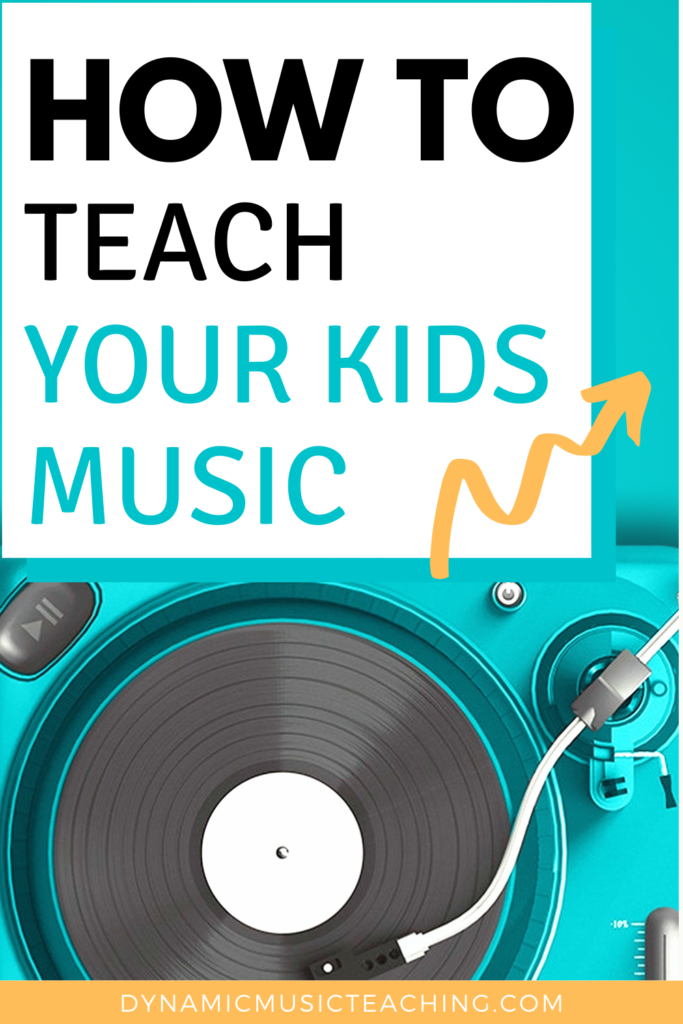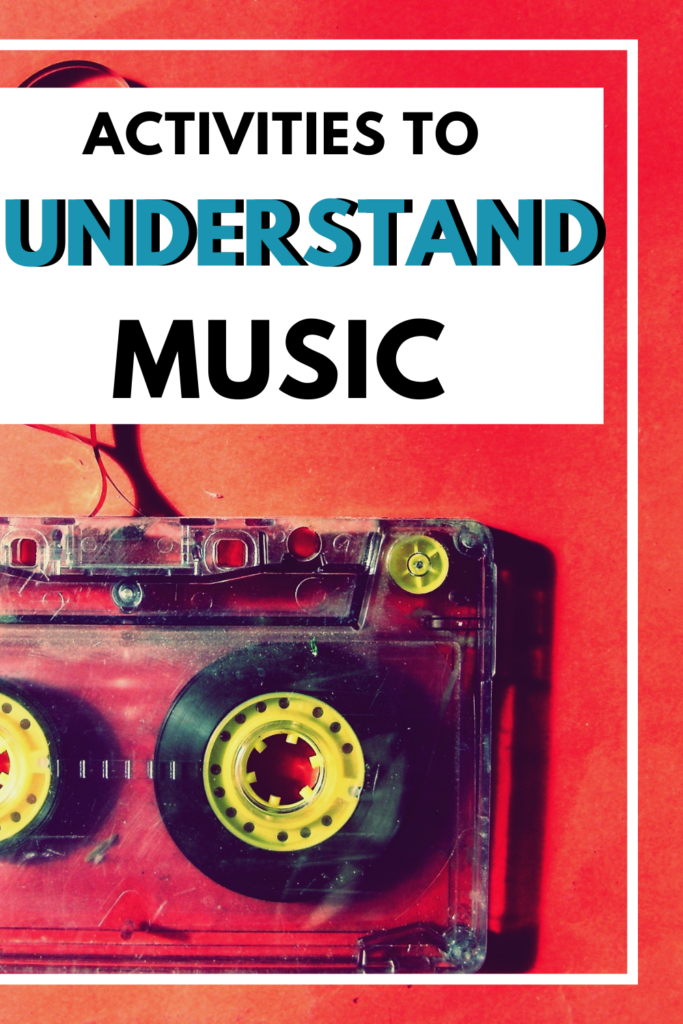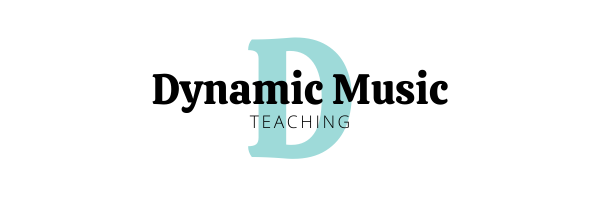How to teach music at home
There are three basic approaches to learning music. We can teach kids to:
- Make music
- Understand music
- Appreciate music
For example, you can make music by playing an instrument. Understand music by learning to read music notation. Appreciate music by being introduced to and learning about a new style of music.
These are just a couple of examples, but you can likely already see how these three ways of learning about music are linked. I’ve put each activity below into one fo these three categories, but most of them fit into at least two. Understanding music helps you make music. And appreciating music makes the other two enjoyable! Ideally, every child would get to experience all 3 approaches.
For example, playing an instrument is difficult without learning to understand music. Not learning to appreciate music is why some children can play an instrument beautifully, but quit as soon as they are allowed to and do not find the joy in music throughout their lives.

Make music
Songs
Singing is a perfect place to start making music. Songs were our first experience with music, perhaps by hearing our mother sing a lullaby. And songs continue to follow us through life as we sing our ABC’s, sing together during a church service, or sing alone while we’re in the shower.
Most children naturally enjoy singing. They often don’t yet have the block teenagers and adults have that they ‘can’t sing’. They just enjoy experimenting with their voices.
Our voices are the most affordable instrument there is!
Singing songs can be used to teach any subject or concept. For example, the ABC’s teach the alphabet, but there arealso songs about colours, shapes, and months of the year. It’s not just for preschoolers either. I’m certain I’ve even heard a song to remember the periodic table somewhere! This is a great way to incorporate music-making then while learning something else.
Singing songs also helps children develop language skills. In addition, repeating and remembering the words to a favourite song develops memory skills and an ability to memorize that will come in handy in all areas of education.
Singing songs also works together with many of the following activities. Sing songs with your kids whenever you can, even if it’s just while cleaning up their toys at the end of the day.
Playing Instruments
Remember when you were worried about how you couldn’t access private lessons, and we talked about alternatives?
A lot of the studies about the benefits of music education specifically studied children learning to both read and make music. Making music encourages problem-solving as well as creativity. Creating music is also a source of relaxation and stress relief for many people.
Rhythm instruments are another great place to start making music since they can easily be made at home. For example, you can make a shaker or maraca out of a plastic egg or toilet paper roll filled with rice, beans, or beads. You can make a drum out of a coffee can or rhythm sticks out of two wooden spoons. Even a plastic cup can be an instrument.
If you would prefer a pitched instrument (one that plays different pitches, not just rhythms), the recorder is one of the most accessible places to start at home. Recorders are very easy to find both online and even in many dollar stores.
Singing. Our voices are instruments. We’ll keep coming back to singing, and it’s the easiest place to start when making music as well.
You very likely already incorporate some singing with your kids. Sing songs with your family at home, encourage them to sing on their own, join a children’s choir if one is available, or sing at your church.
As you can see, the fact that you may not have a piano or a violin is not a barrier to your child playing music at all!

Understand music
Reading Music and music theory
Note reading and understanding basic music theroy helps us to make music – either singing, or playing any instrument.
Reading music not just opens the door to playing any instrument your child might pick up in the future. It also develops reading skills. Learning to read music is learning to read a new language: the language of music. It gives us the opportunity to understand music, and how it is written and created. Just as kids both speak and read their native language, they should be able to both play/sing and read the language of music.
Learn to read music notation. The notes in the treble clef and bass clef are used most often for instruments and singing. Learning to read notes in both these clefs will give your kids the skills to read written music for most instruments. How to read notes on the staff is beyond scope of this guide, but this article will give you some good activities to get started.
Learn basic music theory, musical terms, and structures to give kids the language to talk about music, and to learn how to create music themselves. Learning about the form and structure of a song or piece of music helps us to see how music is created.
Rhythm and a Steady Beat
Rhythm and beat are the framework that music is built on. Learning to read rhythm is an important part of reading written music.
Understanding rhythm, beat, and the difference between them gives us the power to make music with anything, even just our bodies. The beat is the underlying pulse of the music. It remains always the same steady speed like our heartbeat. We will talk more about activities to learn to keep a steady beat in the next section.
Rhythm is the overlying layer. While the steady heartbeat goes always the same speed, the rhythm of the music is the time value of the actual notes. For example, the way the words go in a song is the rhtyhm, while the beat is where you might naturally start tapping your toes along.
Basic rhythms. Learning basic rhythms will involve learning to recognize them, read them, and write them, as well as to clap them and make music with them.
For example, two types of notes are quarter and half notes. Quarter notes are 1 beat long, and half notes are 2 beats long.
Try clapping while saying 1, 1, 1, 1. You are tapping quarter notes.
Try clapping while saying 1-2, 1-2. Only clap when you say 1, not on 2. You are clapping half notes.
Next, try clapping these note values along with some music. Maybe try a rhythm instrument to tap these rhythms along with the music.
Encourage your kids to write down their own combinations of rhythms, and play them with a rhythm instrument.
Cup tapping. For older elementary kids, cup tapping is a very fun way to learn and practice reading and playing rhythms. Cup tapping videos were trendy a couple of years back, because of the Pitch Perfect movie. But even if you’ve never seen the movie or YouTube videos, it is still a fun way to play rhtyhms without an instrument. Try tapping quarter notes with a cup. Then try tapping half notes. You can get much more complex, but this is a good place to start.

Appreciate music
Movement
Movement is integral to how we experience music. We dance and move when we hear a good song. We clap our hands and tap our toes along to the beat. Moving to, and feeling music in our bodies can even be a way of making music in itself.
Combining music and movement makes for physical activity that’s fun! Moving to music also develops motor skills and coordination. Movement activities are also a good way to learn to keep steady beat.
- Movement songs This goes together with the songs we talked about earlier. For example, there are rhymes and songs such as Teddy Bear, Teddy Bear, Head, Shoulders, Knees and Toes, and The Hokey Pokey that teach coordination, listening skills, and body awareness.
- Steady beat. We often clap or sway to music that has a strong beat. Encourage your child to clap along or march in place while listening to music, or singing a song. Most children’s songs have a strong, easy to follow beat. Some children may take some time to learn to follow the beat and that’s just fine.
- Music and movement cards are a fun extension of clapping a steady beat to the music. Once your child is able to clap along, encourage them to move to the beat of the music with other actions. They can tap their toes, sway side to side, tap their knees, and anything else you can think of. Having a deck of cards with actions on them is an easy way to do an activity on the fly, but calling out actions for your kids works as well!
- Moving to music with scarves. If you have any spare scarves around the house, they will make the perfect props for moving to music. Encourage your kids to wave the scarf through the air while moving freely to music. You can take the opportunity to talk about fast and slow music and high and low sounds. Can they move with their scarves to reflect how the music sounds?
- Freeze dance games. There are many names for these games where you dance to music and then must freeze when it turns off. This is a great game to play as a movement break between book-work, or on a rainy day. Try introducing a new style of music here and there, and encourage the kids to move ‘like the music sounds’. Perhaps they will buzz around the room like a bee, or maybe they will skate gracefully around the room.
Stories
Everyone loves storytime. It grabs attention and is enjoyable and very accessible, especially if you have access to a school or community library card. Stories often incorporate rhythmic chanting or a steady beat and singing. These types of stories are often repetitive and encourage both language skills and memory
For example, one of my favourites is Chika Chika Boom Boom. It is an excellent alphabet book best read in a rhythmic chant. It’s such a fun book, it can be enjoyed far past the age where kids are learning their alphabet. Use this book to practice steady beat. Have your kids clap, tap, or stomp along to the beat as you read or listen to the book. If your kids are a bit older and have started learning about music reading and rhythm notation, you might encourage them to write down the rhythm of one of the sentences.
Storybooks about composers’ and musicians’ lives are also a good way to introduce kids to new types of music. They will learn to appreciate a new style of music by connecting to their stories and lives. For example, they could read about a classical composer from long ago, or about a jazz musician, and then become excited to hear what kind of music this person made and loved. Stories can be a good gateway into a new musical style for kids.
In Daily Life
A lot of children’s learning happens outside of formal learning time. For example, you might learn about math while you’re measuring ingredients to bake cookies, or you might learn to read a new word while out shopping.
Music is part of our daily lives already, so this can be the easiest way to start. For example you can:
- Listen to music at home and in the car.
- Attend live of virtual music events such as children’s festivals, local concerts, and events put on by your local library or community centre.
- sing and dance around the house, etc.
If children see the people around them enjoying music on a daily basis, they will learn that music is enjoyable, and not just another subject they must study
History
Much like storybooks, history is also a good gateway into music education. The first place to start is by learning about composers and musicians. You can learn about different countries and cultures through their music. One composer or musician at a time, you can introduce your kids to a wide variety of musical styles they might enjoy.
While ‘old’ classical music sometimes seems irrelevant, learning about it is how we understand current music. The current music you listen to, whatever style it might be, is the result of music’s evolution throughout history. Your kids will be surprised to realize how much influence classical music has had on modern popular music.
Explore. Read about a composer (in a book or online) and then talk about how they lived. When were they alive? What country did they live in? How did people around them dress? What kind of music did they create?
Listen. Once you’ve introduced a composer, its time for some listening activities. Choose a piece of music by the composer to listen to. Can your kids draw a picture to go with the music? You can also begin to introduce musical terms such as tempo (the speed of the music). What is the tempo – is it fast or is it slow? What is the mood – is it happy or sad?
You might enjoy my free printable composer workbook that will guide you through these activities.
Next Steps
Whew! That was a lot! I hope you see now that there are nearly endless opportunities for music education without leaving your home. Have you already tried any of these ideas? Which are your favourites?
Maybe all the info is a bit overwhelming, and you’re not sure where to start? Let’s figure that out together on the last page of this guide.

